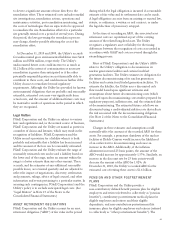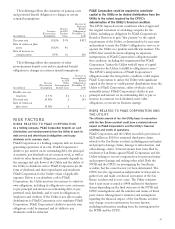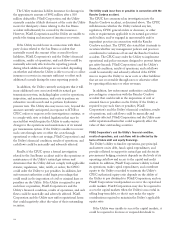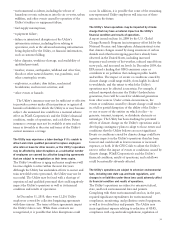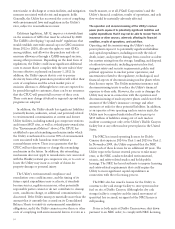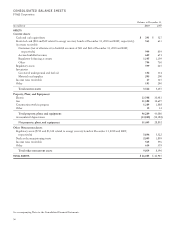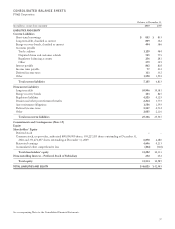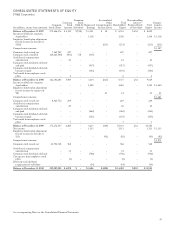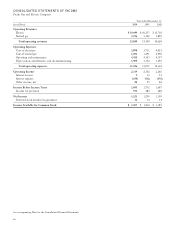PG&E 2010 Annual Report Download - page 55
Download and view the complete annual report
Please find page 55 of the 2010 PG&E annual report below. You can navigate through the pages in the report by either clicking on the pages listed below, or by using the keyword search tool below to find specific information within the annual report.• environmental accidents, including the release of
hazardous or toxic substances into the air or water, urban
wildfires, and other events caused by operation of the
Utility’s facilities or equipment failure;
• fuel supply interruptions;
• equipment failure;
• failure or intentional disruption of the Utility’s
information systems, including those relating to
operations, such as the advanced metering infrastructure
being deployed by the Utility, or financial information,
such as customer billing;
• labor disputes, workforce shortage, and availability of
qualified personnel;
• weather, storms, earthquakes, wildland and other fires,
floods or other natural disasters, war, pandemic, and
other catastrophic events;
• explosions, accidents, dam failure, mechanical
breakdowns, and terrorist activities; and
• other events or hazards.
The Utility’s insurance may not be sufficient or effective
to provide recovery under all circumstances or against all
hazards or liabilities to which the Utility is or may become
subject. An uninsured loss could have a material adverse
effect on PG&E Corporation’s and the Utility’s financial
condition, results of operations, and cash flows. Future
insurance coverage may not be available at rates and on
terms as favorable as the rates and terms of the Utility’s
current insurance coverage.
The Utility may experience a laborshortage if it is unable to
attract andretainqualified personnel to replace employees
who retireorleave forotherreasons, orthe Utility’s operations
may be affected by labordisruptions as a substantial number
of employees are covered by collective bargainingagreements
that are subject to re-negotiationas theirterms expire.
The Utility’s workforce is aging and many employees will
become eligible to retire within the next few years.
Although the Utility has undertaken efforts to recruit and
train new field service personnel, the Utility may not be
successful. The Utility may be faced with a shortage of
experienced and qualified personnel that could negatively
impact the Utility’s operations as well as its financial
condition and results of operations.
At December 31, 2010, there were 12,236 Utility
employees covered by collective bargaining agreements
with three unions. The terms of these agreements impact
the Utility’s labor costs. While these contracts are
re-negotiated, it is possible that labor disruptions could
occur. In addition, it is possible that some of the remaining
non-represented Utility employees will join one of these
unions in the future.
The Utility’s future operations may be impacted by climate
change that may have a material impact onthe Utility’s
financial conditionandresults of operations.
A report issued on June 16, 2009 by the U.S. Global
Change Research Program (an interagency effort led by the
National Oceanic and Atmospheric Administration) states
that climate changes caused by rising emissions of carbon
dioxide and other heat-trapping gases have already been
observed in the United States, including increased
frequency and severity of hot weather, reduced runoff from
snow pack, and increased sea levels. In December 2009, the
EPA issued a finding that GHG emissions cause or
contribute to air pollution that endangers public health
and welfare. The impact of events or conditions caused by
climate change could range widely, from highly localized
to worldwide, and the extent to which the Utility’s
operations may be affected is uncertain. For example, if
reduced snowpack decreases the Utility’s hydroelectric
generation, there will be a need for additional generation
from other sources. Under certain circumstances, the
events or conditions caused by climate change could result
in a full or partial disruption of the ability of the Utility –
or one or more of the entities on which it relies – to
generate, transmit, transport, or distribute electricity or
natural gas. The Utility has been studying the potential
effects of climate change on the Utility’s operations and is
developing contingency plans to adapt to those events and
conditions that the Utility believes are most significant.
Events or conditions caused by climate change could have
a greater impact on the Utility’s operations than has been
forecast and could result in lower revenues or increased
expenses, or both. If the CPUC fails to adjust the Utility’s
rates to reflect the impact of events or conditions caused by
climate change, PG&E Corporation’s and the Utility’s
financial condition, results of operations, and cash flows
could be materially adversely affected.
The Utility’s operationsare subject to extensive environmental
laws, includingnew state cap-and-trade regulations, and
changes inorliabilities underthese laws could adversely affect
its financial conditionandresults of operations.
The Utility’s operations are subject to extensive federal,
state, and local environmental laws and permits.
Complying with these environmental laws has, in the past,
required significant expenditures for environmental
compliance, monitoring, and pollution control equipment,
as well as for related fees and permits. The Utility may
incur significant expense relating to reduction of GHG,
compliance with cap-and-trade regulations, regulation of
51


